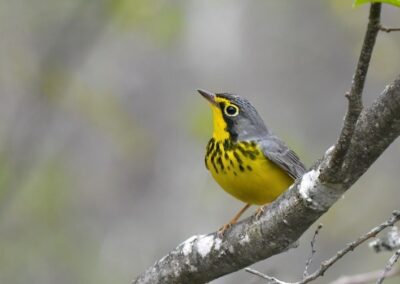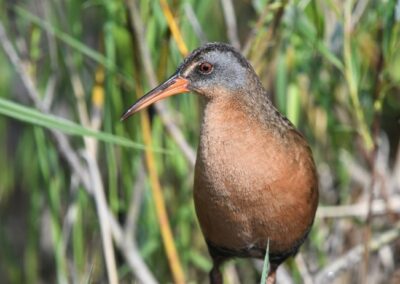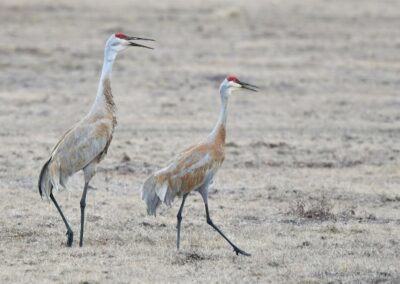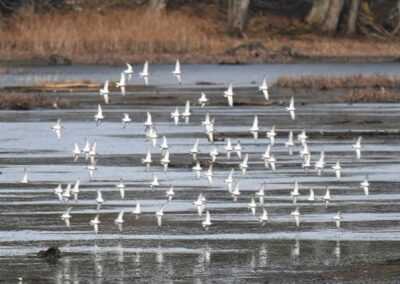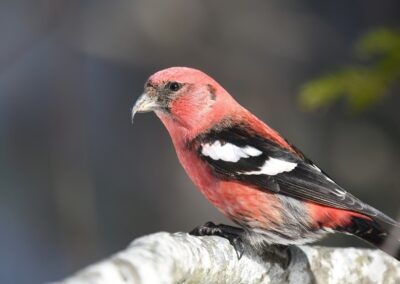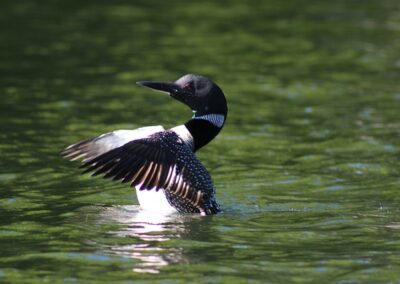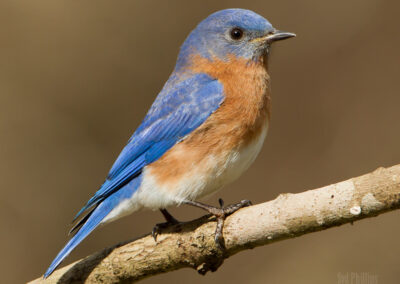Birding in Haliburton County
By Ed Poropats – Naturalist & Photographer
As a local birder and naturalist, I am often asked “Hey, where are some good places to bird locally? What specialty species should I look for?” In this article, I’d like to share some of my favorite places to bird in Haliburton County, and a few species you might look for while at these locations.
The list is by no means exhaustive and is biased toward the south-central part of the county, as that is close to home for me.
Haliburton County Rail Trail
The rail trail originates in the Village of Haliburton and weaves its way south toward Lindsay. Although there are many excellent and interesting stretches worth exploring along this entire route, one of my personal favorites is the first 5 km of this trail.
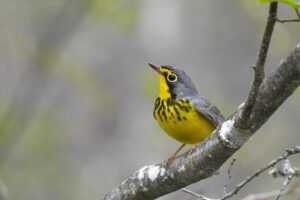 Beginning in a parking area near the village, the rail trail heads south and intersects many interesting habitats along its length. You can wander through black spruce bogs, mixed woodlands, deciduous woods, open grasslands, amazing wetlands, and alder swales, all within a relatively short morning walk or bike ride. Early morning is the best time to visit, as this is a multi use trail and motorized vehicles are rarely encountered in the early hours of the day. A stroll here in mid-May can be a memorable experience, as northbound migrants are seemingly everywhere, refuelling for their continued flight toward breeding grounds. Brightly coloured warblers are the main targets here, with 26 species recorded along those first 5 km. Many of these birds will remain in the area to breed, allowing birders the opportunity to see them even into July.
Beginning in a parking area near the village, the rail trail heads south and intersects many interesting habitats along its length. You can wander through black spruce bogs, mixed woodlands, deciduous woods, open grasslands, amazing wetlands, and alder swales, all within a relatively short morning walk or bike ride. Early morning is the best time to visit, as this is a multi use trail and motorized vehicles are rarely encountered in the early hours of the day. A stroll here in mid-May can be a memorable experience, as northbound migrants are seemingly everywhere, refuelling for their continued flight toward breeding grounds. Brightly coloured warblers are the main targets here, with 26 species recorded along those first 5 km. Many of these birds will remain in the area to breed, allowing birders the opportunity to see them even into July.
The fabulous wetland near km 5 is a wonderful destination. You can sit peacefully on the stone bench, sip your morning coffee, and listen to the songs of Red-winged Blackbirds, Swamp Sparrows, and American Bitterns, or scan the waters for Trumpeter Swan, Wood Duck, or an elusive Virginia Rail. Whether you choose to walk the entire 5 km stretch, or just focus on a small portion of it, the rail trail rarely disappoints.
Ritchie Falls Loop
Ritchie Falls near Lochlin is a favorite destination for sightseers and picnickers during the summer months. But the area is also interesting from a birding perspective. Open grasslands are not a very common habitat in Haliburton County, with the majority of the region covered in forests. Lochlin is an exception. This 5 km loop offers a variety of habitat types, with some excellent grassland type habitats and outstanding wetlands. And, of course, the scenic Ritchie Falls itself.
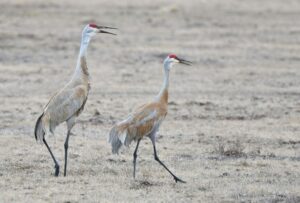 I usually park at the Lochlin Community Center and walk toward Ritchie Falls Road, but you can also drive the road, and stop frequently to scan. As you walk or drive, stop and check the open fields for typical grassland species such as Eastern Meadowlark, Bobolink, Eastern Bluebird, Northern Shrike (winter) and American Kestrel. Sandhill Cranes are frequently observed here. Further along the road is the Lochlin Bog, an Area of Natural and Scientific Interest (ANSI). Winnowing – a display by the males that creates a haunting, almost ghost-like sound – Wilson’s Snipe are common here, and Northern Harriers drift lazily up and down the creek. Listen for the dry rattle of the uncommon Sedge Wren.
I usually park at the Lochlin Community Center and walk toward Ritchie Falls Road, but you can also drive the road, and stop frequently to scan. As you walk or drive, stop and check the open fields for typical grassland species such as Eastern Meadowlark, Bobolink, Eastern Bluebird, Northern Shrike (winter) and American Kestrel. Sandhill Cranes are frequently observed here. Further along the road is the Lochlin Bog, an Area of Natural and Scientific Interest (ANSI). Winnowing – a display by the males that creates a haunting, almost ghost-like sound – Wilson’s Snipe are common here, and Northern Harriers drift lazily up and down the creek. Listen for the dry rattle of the uncommon Sedge Wren.
Eventually, you’ll cross the Burnt River, where the water tumbles wildly over Ritchie Falls. Just beyond the bridge is the rail trail. You can finish the loop by wandering northward along this trail, back towards Lochlin. As you walk (cars are not permitted along the rail trail), you will be paralleling a large, wooded swamp. Look or listen for Alder Flycatcher, Merlin, Wilson’s Warbler (during migration) and American Redstart. The rail trail eventually brings you back to Ritchie Falls Rd., within sight of your car at the Community Center.
Horseshoe Lake Wetland
The east side of Horseshoe Lake, between Duck Lake Rd. and Shuyler’s Island, harbours a large, productive, provincially significant wetland. Although this 1.2 km stretch of road (from the base of Shuyler’s Island, across the causeway, and north to the edge of the Blairhampton Golf Course) can offer some stellar birding opportunities at any time of the year, autumn is my favorite time to visit this gem.
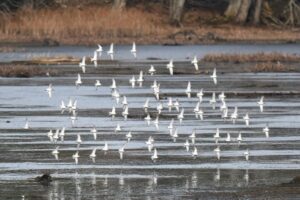 During the spring and summer months, typical wetland birds can be found here….rails, bitterns, Marsh Wrens (locally rare), herons, and nesting ducks and grebes. But when fall arrives, and the water level is drawn down, extensive mudflats begin to appear. During this time, this wetland can yield exceptional local birds. The marsh is a staging area for migratory waterfowl, and it is not uncommon to see several hundred ducks and geese dotting the surface of the water. It’s always a challenge to look through these flocks in search of rarer birds, but it can also be extremely satisfying! 24 different species of waterfowl have been recorded here, more than any other location in Haliburton County.
During the spring and summer months, typical wetland birds can be found here….rails, bitterns, Marsh Wrens (locally rare), herons, and nesting ducks and grebes. But when fall arrives, and the water level is drawn down, extensive mudflats begin to appear. During this time, this wetland can yield exceptional local birds. The marsh is a staging area for migratory waterfowl, and it is not uncommon to see several hundred ducks and geese dotting the surface of the water. It’s always a challenge to look through these flocks in search of rarer birds, but it can also be extremely satisfying! 24 different species of waterfowl have been recorded here, more than any other location in Haliburton County.
The list of rarities includes Canvasback, Redhead, Northern Pintail, Gadwall, Surf Scoter, and Black Scoter. Trumpeter Swans are a regular sight here in the fall. But the mudflats also attract shorebirds, migrating south from the high arctic. Dunlin, Pectoral, White-rumped, and Solitary Sandpipers, Greater and Lesser Yellowlegs, have all been recorded here. In addition, the mudflats provide foraging opportunities for Rusty Blackbirds, Horned Larks, Lapland Longspurs, and Snow Buntings. Bald Eagles are an expected species. This wetland can pack a lot of punch in a very small area!
Livingstone Lake Road
The Livingstone Lake Road is located near the northwest corner of the county and offers some fabulous boreal flavour to the Haliburton birding experience. This 5.5 km (one way) walk or drive is one of my favorite winter excursions, especially during years when northern finches irrupt into the region.
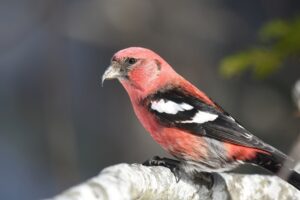 I usually park in a large, open roadside space at the intersection of Livingstone Lake Rd. and the dirt road that leads into Livingstone Lake Lodge. You can then walk north to the Troutspawn Lake Rd. intersection. In years of heavy cone crops and when winter finches push south, this quiet road can be bustling with birdlife in mid-winter, and the photographic opportunities are second to none. The further you travel along the road, the more boreal it becomes. Both Red and White-winged Crossbills can be seen and/or heard, often coming down to the road to pick grit. Evening and Pine Grosbeaks can be common.
I usually park in a large, open roadside space at the intersection of Livingstone Lake Rd. and the dirt road that leads into Livingstone Lake Lodge. You can then walk north to the Troutspawn Lake Rd. intersection. In years of heavy cone crops and when winter finches push south, this quiet road can be bustling with birdlife in mid-winter, and the photographic opportunities are second to none. The further you travel along the road, the more boreal it becomes. Both Red and White-winged Crossbills can be seen and/or heard, often coming down to the road to pick grit. Evening and Pine Grosbeaks can be common.
The smaller finches such as Common Redpolls, Pine Siskins, Purple Finches, and American Goldfinches can be abundant, often observed in large flocks on the road. Add to this the possibility of seeing Black-backed Woodpecker (rare further south), a Moose, or an American Marten and you’ve got a recipe for a fantastic day of birding. Combine this with a crisp, sunny, blue-sky day, and a quiet, rarely travelled roadway, and you’ll be guaranteed a magnificent experience.
Be sure to check out our Two Day Itinerary that takes you to many of our Parks and Wetlands, perfect for bird watching.

